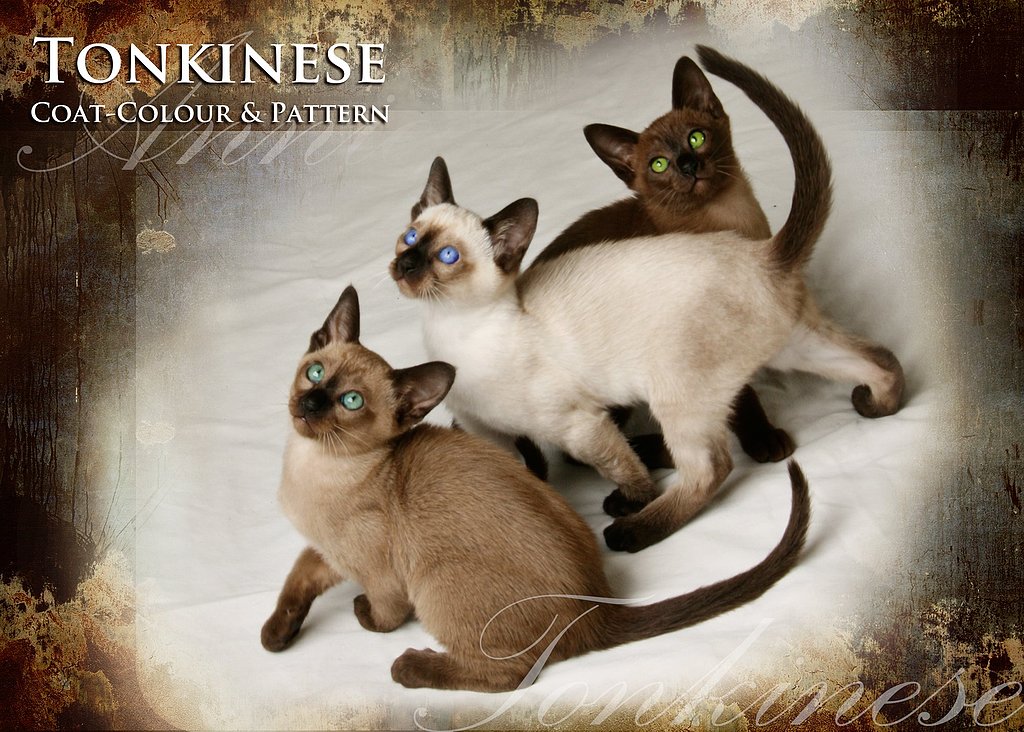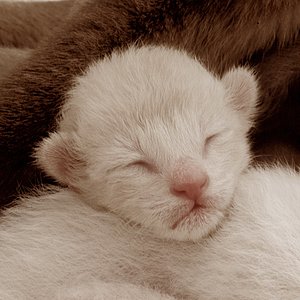 Tonkinese Coat Colour & Pattern
Tonkinese Coat Colour & Pattern
One of the most attractive aspects of the Tonkinese is the variations in colour and pattern that are possible within the breed. However the colours and patterns that exist in the Tonkinese breed can be very confusing for the newcomer to the breed, and it can be difficult to understand the relationship between the colours and patterns that characterise the breed.
In this section we explore the colours and patterns that define the Tonkinese breed, and we focus particularly on the basic colours and patterns. However there are other colours and patterns permitted within the Tonkinese breed, depending on the country of origin and the Cat Registry rules as the apply to the individual breed standards.
Basic Colours & Patterns
At Anniesong we breed the basic colours of Seal, Chocolate, Blue & LiIac and with the exciting addition of Cinnamon & Fawn we now offer 6 colours and 3 variations of pattern for each colour.
Thus we now have a possible 18 colour/pattern combinations that can be expressed within our gene pool.
............... so how do we get 18 colour and pattern combinations ?
Each of the 6 colours is expressed in one of 3 patterns ie;
- Solid - (Burmese expression of colour),
- Mink - (a blend of the Burmese / Siamese expression of colour)
- Point - (Siamese expression of colour),
for more information on colour and patterns check out the 'genetics pages.
This chart is designed to visualise and convey the colours and patterns that we breed here at Anniesong, and to describe the relationship between each colour and their respective patterns.
As there are 6 colours but 3 different variations of pattern with each - there are thus 18 possible colour/pattern combinations that we breed.
Here we have only focussed on the colours and patterns that we breed at Anniesong and therefore this chart does not include the red & tortie series, nor tabbies or caramel coloured cats that are accepted within the breed standard of some registries here in Australia.
The chart is ordered with each of what's known as the 'dense' colours first, followed by the 'dilute' version of each. Seal is thus followed by Blue, (diluted Seal), Chocolate is followed by Lilac (diluted Chocolate) and Cinnamon is followed by Fawn (diluted Cinnamon)
Thus there are 3 'dense' colours; Seal, Chocolate & Cinnamon...... and their 3 'dilute' versions; Blue, Lilac & Fawn.
As illustrated in the chart, the dilute gene creates a much lighter and 'greyer' version of the colour it is combined with.
When you observe the 'Point' patterned and 'Solid' patterned Tonkinese, it is easy to see that the 'Mink' is a blend of the two other patterns, for more on the fascinating genetics that give rise to the breed visit the genetics page.
Essentially the patterns vary in the degree of contrast between the point colour and the body colour, with the 'Point' pattern exhibiting the highest contrast and the 'Solid' exhibiting the least.
In each pattern the point colour remains the same but visually the points will appear darker where the points are seen against a lighter body tone. As an example the point colour can appear darker on a Chocolate-Point than that of a Chocolate-Mink.
Coat colour and pattern take a long time to fully develop and often only when the cat has reached maturity. As such the kitten colours are 'duller' - less rich in tone and this is often also the case for eye colour.

Each row illustrates the 3 variations of pattern that are seen in each of the standard colours
Coat Colour Chart for Kittens
This colour & pattern guide is intended to visually convey the colours and patterns of Tonkinese kittens in comparison to one another... Each image has been produced under identical lighting conditions, enabling a true comparison between colours - please make allowances for individual monitor settings as this will affect how the colours perceived. All kittens depicted have been bred here at Anniesong.
This chart does not include the new colours; Cinnamon & Fawn, yet these will be added in due course. We will also eventually produce a photographic colour chart comprising all adult expressions of colour and pattern.... including the new colours; Cinnamon & Fawn.

The kittens depicted vary in age from 9 -12 weeks
Seal
The colour named 'Seal' is the darkest of colours and the original colour that originally defined the Siamese, Burmese & Tonkinese breeds.
Seal is actually the gene for black when combined with the Himalayan gene that creates 'points' in the markings of a cat
Blue
The colour 'Blue' is the result of 'Seal' combined with the dilution gene.
Blue is known as the least contrasty of the colours and so if you look at the body and point colour of the Blue-mink you will see very little difference between contrast. It is easy to mistake a Blue-Mink for a Blue-Solid
Chocolate
The colour 'Chocolate' when seen in a non-pointed cat is a rich dark brown. The Himlayan gene that creates points, also has a 'washing-out' or weakening effect on the colour of chocolate expressed.
Chocolate is also the most contrasty of the colours with great contrast seen in the mink in particular - even with the 'solid' pattern the points are clearly visible and stand out from the body tone.
Lilac
The colour 'Lilac' is the result of 'Chocolate' combined with the dilution gene.
Lilac is a lighter colour than blue, and exhibits a warmer tone that is derived from the gene for chocolate.
Due to it's relationship to the gene for chocolate, the points are still quite apparent on a Lilac-Solid.
How Colours are named causes much confusion
when researching the breed.
This is due not only to the fact that some colour
names don’t seem to describe the colour very well,
but also due to the reality that different names are
used to describe the same colour.
Seal is called 'Natural' in the USA, 'Brown' in the
UK & NZ, yet in Australia, Seal is the most often used name and is arguably the most appropriate.
Comparative names for colours overseas;
The names used in Australia to describe Tonkinese colours, are substituted in other countries as follows;
Seal = Natural (US) / Brown (UK)
Chocolate = Champagne (US)
Blue = Blue
Lilac = Platinum (US)
Cinnamon = Honey (US)
Fawn = Fawn
Factors that affect accuracy of colour online
Tonkinese colours are very subtle and don't photograph well.
Colour in the environment reflects onto the coat creating incorrect colour casts.
Variable-coloured light changes the coat colour.
Monitors vary massively in how they display colour making it problematic to choose colour online.
Confusion between the 3 main colours; Seal, Chocolate & Cinnamon
People frequently enquire after a Chocolate Tonk on the phone or via email, yet when they visit they point to the Seal Tonk as their desired colour. As the colour Seal is darker, the assumption is often that this colour be identified as Chocolate.
In explanation of the differences between the main colours (non-dilute), I find that it is helpful to compare ‘Seal & Chocolate’ with the two types of edible chocolate,
‘Seal’ is similar to the colour of dark chocolate.
‘Chocolate’ is similar to the colour of milk chocolate.
‘Cinnamon’ is as the name suggests similar to the colour of cinnamon powder.

A comparison between Seal, Chocolate & Cinnamon
Yet here is Australia, depending on individual Cat Registry rules, the breed-standard allows generally for a more limited range of colour/pattern combinations. Thus it is rare to see Tabbies, Torties, Reds & Creams.
Although permitted in several Australian breed standards, Caramel is not to my knowledge represented in Australian gene pools.

Tabby-Mink Tonkinese from UK
owned by Sue Arnold (Suantre)
Tabby Tonkinese are popular in Europe and although a couple of local breeders did work on developing the pattern in Australia, the Tabbies were not popular with buyers.

Cream-Mink Tonkinese - Australia
owned by Heather Redmond (Tinkatonks)
Cream is a dilute of the colour Red and may be a non-sex-linked colour when breeding from a red or cream female. Bred to a red or cream male - only red/cream will be produced.

Blue Tortie-Solid Tonkinese from UK
Tortoiseshell Tonks (or Torties) are very oppular in Europe & New Zealand but have until recent times failed to find favour in Australia. Some stunning Torties are being bred in Victoria.
As the Gene for the Red & Tortie series are sex-linked, Males are generally Red or Cream, while Tortoiseshell, being exclusively female, may be expressed as either Seal, Chocolate or Lilac-based paired with Red, or expressed as Blue, Lilac, or Fawn based, paired with Cream.
Juvenile coat-colour development
Essentially all the colours begin as being far lighter on the body of a kitten than that seen in the adult, the degree of 'lightness is principally connected to the characteristics of the colour itself and their pattern, ie; if they are Point, Mink or Solid patterned.
Point-Pattern Kitten / Colour @ birth
Seal-Point = dirty white (tinged greyish)
Blue-Point = dirty white (tinged greyish)
Chocolate-Point = pure white
Lilac-Point = pure white
Cinnamon-Point = pure white
Fawn-Point = pure white
Mink-Pattern Kitten / Colour @ birth
Seal-Mink = light coffee
Blue-Mink = light coffee
Chocolate-Mink = pale cream (just off-white)
Lilac-Mink = pale cream (just off-white)
Cinnamon-Mink = pale cream (just off-white) Fawn-Mink = pale cream (just off-white)
Solid-Pattern Kitten / Colour @ birth
Seal-Solid = dark coffee
Blue-Solid = mid-grey
Chocolate-Solid = light golden brown
Lilac-Solid = taupe (greyish gold)
Cinnamon-Solid = pale gold
Fawn-Solid = beige
Prior to birth all kitten colours and patterns are to varying degrees supressed by the temperature of the womb, that has a bleaching effect on the developing colour
The following series of 12 images depict Anniesong Jagger at various ages, up to 10 weeks of age, demonstrating the typical progression of his coat-colour from the pale coffee colour at birth to the rich and warm tone of an adult Seal-Mink Tonkinese. He is seen here with his Seal-Mink mum; to illustrate how the colour and pattern will eventually appear.

@ Birth - While still wet after its birth,
a Seal-Mink kitten appears darker than it will be once it has been cleaned up by mum and is dry.

@ 1 day old - Seal-Mink kittens begin life as a pale coffee colour and with a slight tint to the nose leather. A Blue-Mink will be identical at this age.

@ 1 week old - Jagger's pattern is beginning to develop. His nose leather displays a brownish tone and the ear seams start to develop colour.

@ 10 days old - With eyes now fully open, his point colour is continuing to develop, as his body begins to gain a darker and richer tone.

@ 2 weeks old - While still very different in tone to an adult, it is now clear that the kitten is a Seal-Mink.

@ 3 weeks old - Jagger is still much paler than mum, but continues to strengthen in both colour & pattern.

@ 4 weeks old - The colour on his nose has spread to his 'mask' and the characteristic 'points' are becoming more evident.

@ 5 weeks old - Jagger's body is now a lot darker and his points are continuing to darken also.

@ 6 weeks old - The 'points' are now quite dark and stand out distinctly from the body colour.

@ 7 weeks old - The point colour continues to darken and become more distinct from the body colour.

@ 9 week old - Jagger's coat colour & pattern are still developing, but he is still a 'duller' tone than that of an adult.

@ 10 week old - His Points have strengthened but it will be many more months before the full expression of adult colouration is reached.

